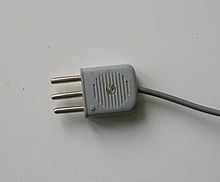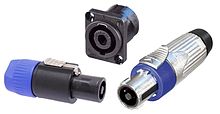Speaker connector
Loudspeaker plugs are used to connect external loudspeakers to amplifiers.
Loudspeaker plugs up to the 1960s
Loudspeaker plugs were used here to connect external sound converters to tube receivers and for 100 V technology in the PA area. The sockets are designed with three pins and mechanically resemble modern Euro plugs . They have the same pin diameter (4 mm) and 19 mm pole spacing - they also have a third similar contact in the middle so that these plugs cannot be plugged into 230 V mains sockets . The connection sockets are compatible with banana plugs .
Occupancy:
- External contacts = output and ground
- Center contact = mostly not used, or ground; to avoid confusion with the very similar cartridge connector;
Since this connector standard basically allows an interchanged insertion by 180 °, to ensure a connection with the correct phase (here interchanging ground and phase), a marking with a colored dot or a mark is attached to the connector as well as to the device or a socket.
Another possibility to prevent device malfunctions by reversing the insertion is an additional or exclusive (without using one of the external contacts) assignment of the central contact. In order to fundamentally remedy this deficiency, the measuring device plug was introduced uniformly for the more professional laboratory area .
HiFi plug
Loudspeaker plug according to DIN 41529

The connection standardized according to DIN 41529, also known as the loudspeaker plug, was introduced in 1959 to replace the old loudspeaker plugs that were not protected against polarity reversal. It was not widely used until the mid-1960s. Colloquially it is also referred to as "LS plug" or "dash-dot plug". It was particularly popular in the hi-fi sector until the 1980s. The round contact is usually assigned the signal or "+", while the flattened side is assigned to ground or "-". A disadvantage here is the relatively small contact elements and the resulting high resistance , which is why these plugs form is only suitable for small capacities.
Other types of connections
Since the late 1980s, loudspeaker connections have often been made using spring clips into which the loudspeaker braided cables are clamped directly. Higher quality devices use banana sockets with integrated screw terminals. The cable can be attached to a banana plug and plugged in, or clipped directly. The latter is preferable because of the lower contact resistance. The ground contact is usually black, the phase colored red. The cables are usually not permanently connected to loudspeaker boxes either, but rather via such connectors.
Professional and semi-professional connectors
Jack plug
Instrumental amplifiers in public address technology traditionally use jack connectors to connect internal and / or external speakers. Although the Speakon standard created specifically for speaker connections has existed since the 2000s, jack sockets and plugs are used, especially for devices in the low to medium price range. Disadvantages of this connection variant are:
- The contacts are not touch-safe. The SELV voltage limit value (25 volts alternating voltage) is easily exceeded.
- High currents flow, which stress the jack connector system to the limit. With a power of 500 watts and a loudspeaker impedance of 4 ohms, a current of more than 10 amps already flows.
- When the plug is pressed into the socket on the loudspeaker box, the amplifier is short-circuited and can be destroyed.
- Inputs and outputs of devices as well as switching inputs (all usually in 6.35 mm jack) can be mixed up, which means that high electrical power can be fed into sensitive inputs or outputs can be switched in parallel in an impermissible manner.
- Tube amplifiers must not be operated without speakers. If the plug contact comes loose, the amplifier can be destroyed.
For very inexpensive audio devices, 3.5 mm jack plugs are sometimes used. In principle, the same problems exist here, but these are of minor importance because of the low power transmitted.
XLR connections
XLR plugs are mainly used for symmetrical signal transmission in the high-impedance range ( microphone connections ). Three-pin XLR connectors are also used in the semi-professional and professional sector for connecting loudspeaker boxes . In the power range, dangerous touch voltages can be present at the plugs and the male XLR is not touch-safe. Therefore, in rare cases (mostly four-pin) XLR plugs with touch-protected female output are used.
Speakon
Speakon is a loudspeaker connector developed and manufactured by Neutrik for the professional audio sector. It is characterized by robustness, high contact load capacity of 20 amps and secure locking.
Speakon connectors are available as two-pole, four-pole and eight-pole versions, whereby the two- and four-pole types are compatible with each other. The eight-pole version differs in its larger design. Due to the number of available contacts in just one connector, it is possible to connect multi-channel passive systems, satellite subwoofer systems or multi-channel monitor- speaker constellations with just one cable. Speakon has established itself as a quasi-standard worldwide in the professional audio sector.




